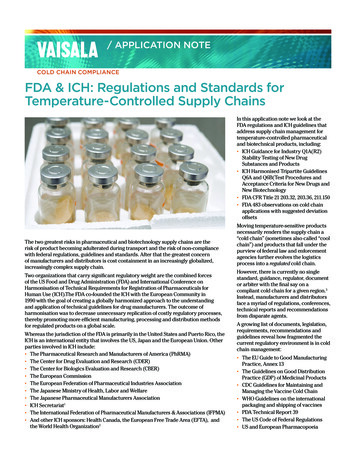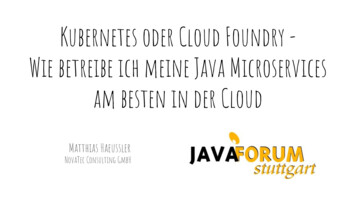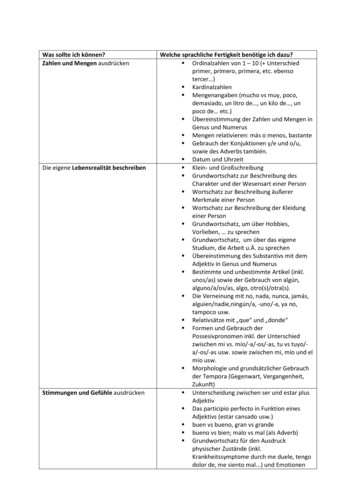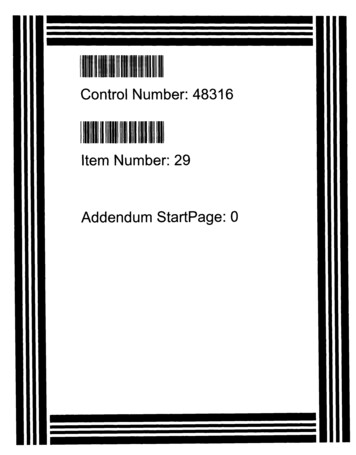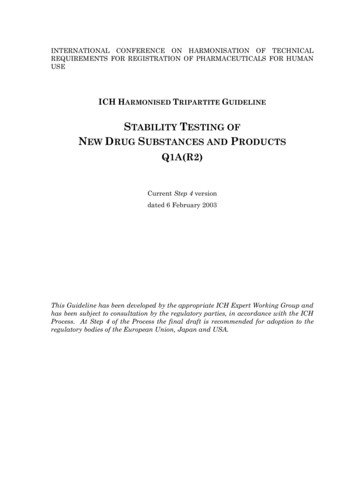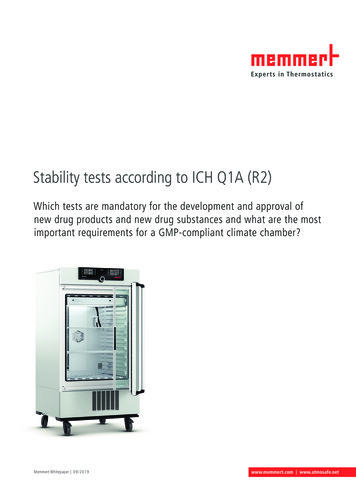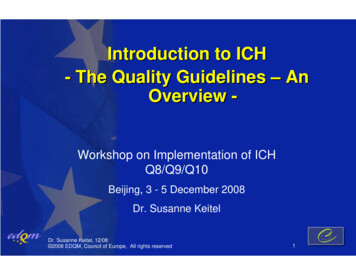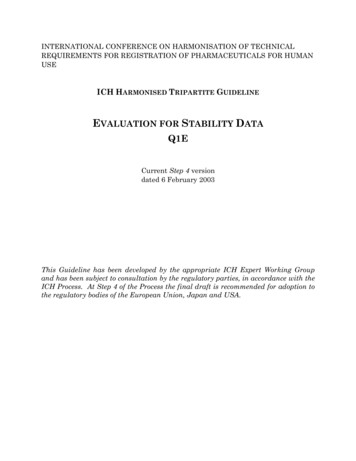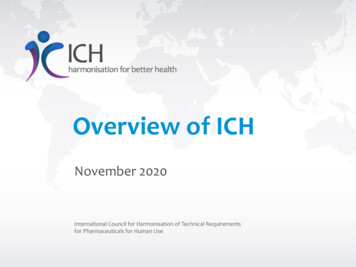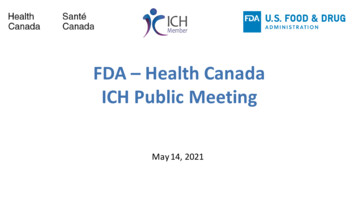
Transcription
FDA – Health CanadaICH Public MeetingMay 14, 2021
Agenda Welcome and Opening RemarksOverview of ICHTopics Recently Reaching ICH MilestonesE6 PrinciplesQ12 ImplementationModel Informed Drug DevelopmentPatient Focused Drug DevelopmentQ&A/Comment Periodwww.fda.gov2
FDA and Health CanadaRegional ICH ConsultationOpening RemarksMay 14, 2021Theresa M Mullin, PhDAssociate Director for Strategic InitiativesFDA Center for Drug Evaluation and Research
Our regional meeting supports the original aims of2015 ICH ReformsGoals for ICH Reform in 20151. Focus global pharmaceutical regulatory harmonisation work in one venue.2. Create a venue that gives to all key pharmaceutical regulatory authorities andindustry stakeholders the opportunity to be more actively involved inpharmaceutical harmonisation work.3. Maintain efficient and well-managed operations and harmonisation workprocesses.The ICH Association, established in October 2015, is a non-profit legal entity under Swisslaw with the aim to focus global pharmaceutical regulatory harmonisation work in onevenue. http://www.ich.org/about/articles-procedures.html2
Regional Meetings provide another opportunity for ICHand stakeholder engagement Since ICH reforms: Growing participation of regulators and industry in work to harmonizescientific and technical standards for human drugs Increasing recognition of need for external stakeholder engagementand consultation Expanding opportunities for public input via EWG workshops,publication of Reflection Papers for public comment (e.g., GCPRenovation paper)3
Significant Global Growth in the Number and Diversity of ICH ParticipantsICH Members & ObserversMEMBERSFounding RegulatoryMembersEC, EuropeFDA, United StatesMHLW/PMDA,JapanFounding IndustryMembersEFPIAJPMAPhRMAStanding RegulatoryMembersHealth Canada,CanadaSwissmedic,SwitzerlandMEMBERS (continued)Regulatory MembersANVISA, BrazilHSA, SingaporeMFDS, Republicof KoreaNMPA, ChinaTFDA, ChineseTaipeiTITCK, TurkeyIndustry MembersGlobal Self-CareFederationIGBABIOOBSERVERSStanding ObserversIFPMAWHOOBSERVERS (continued)Legislative or AdministrativeAuthoritiesANMAT, ArgentinaCDSCO, IndiaCECMED, CubaCOFEPRIS, MexicoCPED, IsraelINVIMA, ColombiaJFDA, JordanMMDA, MoldovaMOPH, LebanonNational Center,KazakhstanNPRA, MalaysiaNRA, IranRoszdravnadzor, RussiaSAHPRA, South AfricaSCDMTE, ArmeniaSFDA, Saudi ArabiaTGA, AustraliaOBSERVERS (continued)Regional HarmonisationInitiatives (RHIs)APECASEANEACGHCPANDRHSADCInternational PharmaceuticalIndustry OrganisationAPICInternational Organisationregulated or affected by ICHGuideline(s)Bill & Melinda GatesFoundationCIOMSEDQMIPECPIC/SUSP444
Approach to promoting ICH standards globally Guideline Relevance Focus harmonized guideline work on topics directly relevant to the quality andefficiency of drug development, regulatory review, manufacturing, post-approvaloversight Scientific Rigor Focus on data-driven consensus-based scientific standards, with work processes thatare inclusive and transparent Implementation Support through training and continued monitoring progress and challenges inimplementation5
FDA and Health Canada Regional ICH Consultation -Presentations Overview of ICH Jill Adleberg, FDA Guidelines Recently Reaching ICH Milestones (S1 and Q3C) Alisa Vespa, Health Canada Guideline Work On-going: ICH E6 GCP Principles Khair ElZarrad, FDA Guidelines in Implementation: ICH Q12 Ashley B. Boam, FDA ICH Discussion Groups: Model Informed Drug Development Scott Marshall, PhRMA (Pfizer) ICH Reflection Papers: Patient Focused Drug Development Robyn Bent, FDA Q&A/Comment Period6
Thank you7
ICH OverviewJill AdlebergICH CoordinatorInternational Programs, Office of the Center DirectorCDER US FDAFDA/HC ICH Regional Public Meeting – May 14, 2021
ICH Overview The International Council for Harmonisation of Technical Requirements ofPharmaceuticals for Human Use (ICH) is a unique harmonization organisationinvolving regulators and the pharmaceutical industry. Launched in 1990 by the US, EU, and Japan. Canada, Swissmedic and WHO asobservers. Well-defined objectives:– To improve efficiency of new drug development and registration processes– To promote public health, prevent duplication of clinical trials in humans andminimize the use of animal testing without compromising safety andeffectiveness Accomplished through development of harmonized, technical guidelines andstandards that are implemented by regulatory authorities.www.fda.gov2
ICH AssociationReformed as a non-profit legal entity under Swiss Law in 2015 to promotepublic health through international harmonization that contributes to:– Focus global pharmaceutical regulatory harmonization work in a singleforum for constructive dialogue on scientific issues– Promote more involvement from regulators around the world and widerinclusion of global industry sectors– Continue to harmonize and streamline the global drug developmentprocess for the benefit of patients around the world– Facilitate greater adoption of new and improved research anddevelopment approaches, common standards, and therapeutic advances– Maintain efficient and well-managed operationswww.fda.gov3
ICH Members and ObserversMembersFounding Regulatory Members EC, Europe FDA, US MHLW/PMDA, JapanFounding Industry Members EFPIA PhRMA JPMANMPA, ChinaTITCK, TurkeyTFDA, Chinese TaipeiStanding Regulatory Members Health Canada, Canada Swissmedic, Switzerland Regulatory Members ANVISA, Brazil HSA, Singapore MFDS, Republic of KoreaIndustry Members BIO Global Self-Care Federation IGBAObserversStanding Observers IFPMA WHOLegislative or Administrative Authorities ANMAT, Argentina CDSCO, India CECMED, Cuba COFEPRIS, Mexico CPED, Israel INVIMA, Colombia JFDA, Jordan MMDA, Moldova MOPH, Lebanonwww.fda.gov National Ctr, KazakhstanNPRA, MalaysiaNRA, IranRoszdravnadzor, RussiaSAHPRA, South AfricaSCDMTE, ArmeniaSFDA, Saudi ArabiaTGA, AustraliaRegional Harmonization Initiatives APEC ASEAN EAC GHCPANDRHSADCInt’l Pharmaceutical Industry Organizations APICInt’l Orgs regulated by or affected by ICH guidelines Bill & Melinda Gates Foundation CIOMS EDQM IPEC PIC/S USP4
ICH Products 70 guidelines on technical requirementsrelated to human drugs Electronic Standards for the Transfer ofRegulatory Information (CTD/eCTD, ICSRs) Medical Dictionary for Regulatory Activities(MedDRA) -- standardized medical terminologyto facilitate regulatory information sharingwww.fda.gov5
Major ICH Topic AreasSafety Carcinogenicity studiesGenotoxicity studiesToxicokinetics and PharmacokineticsDuration of chronic toxicity testingReproductive toxicology Clinical safetyClinical study reportsDose-response studiesGood clinical practice StabilityAnalytical validationImpuritiesPharmacopoeiasSpecifications MedDRA terminologyElectronic standardsNonclinical safety studiesCTD and eCTDBioanalytical Method ValidationBiopharmaceutics Classification System-based Biowaivers Safety pharmacology studiesImmunotoxicology studiesNonclinical evaluation for anticancer pharmaceuticalsPhotosafety evaluationNonclinical pediatric safety Clinical trialsClinical evaluation by therapeutic categoryClinical evaluationPharmacogenomics Good manufacturing practicePharmaceutical developmentQuality risk managementPharmaceutical quality systemDevelopment and manufacture of drug substances Data elements and standards fordrug dictionariesGene therapyMutagenic impuritiesDrug Interaction StudiesBioequivalence for IR solidEfficacyQualityMultidisciplinarywww.fda.gov 6
Composition of ICH Working GroupsOver 700 experts in 34 working groupsStanding Observer,30, 4%Other, 5, 1%Observer, 62, 8%Member, 212,29%www.fda.govFounding/StandingMember,433, 58%7
ICH Guideline Development5 Step ProcessProcessFive-Stepwww.fda.gov8
ICH TrainingGuideline Training: ICH is working to ensure that high quality training is available basedupon scientific and regulatory principles outlined in its guidelines.Efforts include:www.fda.gov Development of a Training Library on the ICH website with access to alltraining materials including Step 4 working group presentations. Funding support for training programs organized by ICH regulatorymembers and observers. ICH Recognized Training Programs hosted by a variety of organizations,associations, regulatory authorities and academia. Offered in-person,virtually, and online. Information available on the ICH website. Online training materials development including some translations.9
ICH GovernanceAssembly The overarching body, comprised of all ICH Members and Observers,that makes decisions regarding the Articles of Association and its rulesand procedures, admission of new members, election of ManagementCommittee representatives, adoption of ICH guidelines, etc.Management Committee Oversees operational aspects on behalf of all members of theAssociation, including administrative and financial matters and oversightof WG operations.www.fda.gov Financial responsibilities include preparation of the ICH budget and,during a transition period, ensure funding of ICH operations. Includes Permanent and Standing Members, and Elected Members10
ICH Governancewww.fda.gov11
Eligibility Criteria: RegulatorsRecognized Authority Has a legal personality Responsible for regulation of pharmaceuticals for human useEngagement in the ICH Process Past regular attendance in at least 3 ICH meetings during theprevious 2 consecutive years Past appointment of experts in at least 2 working groupsApplication of ICH GuidelinesAt minimum, implemented the following guidelines:www.fda.gov–––Q1: Stability TestingQ7: Good Manufacturing Practices for Active Pharmaceutical IngredientsE6: Good Clinical Practice12
Eligibility Criteria: IndustryRecognized Authority Has a legal personality Represents members from several countries in atleast three continents Organization or its members regulated by ICHguidelinesEngagement in the ICH Process Has participated in ICH as an observer Past regular attendance in ICH meetings Past appointment of experts in 2 working groupswww.fda.gov13
SummaryICH: Draws on expertise of regulators and industry toachieve international harmonization of technicalguidelines to enhance public health Uses a transparent, science- and consensus-basedprocess for guideline development includingopportunities for public comment Includes commitment of regulators to implementguidelines Has expanded global participation and engagementthrough recent reformswww.fda.gov14
Topics Recently Reaching Step 3 or 4 of the ICH Process:ICH Q3C(R8) & Addendum to ICH S1B(R1)14 May 2021Alisa Vespa, Ph.D.Office of Risk ManagementBureau of Medical SciencesTherapeutic Products Directorate, Health Canada
Presentation outline Q3C(R8): Impurities: Guideline for Residual Solvents Permitted daily exposures (PDEs) for 3 new solvents S1B(R1): Testing for Carcinogenicity of Pharmaceuticals Addendum to S1B Expands the testing scheme for assessing humancarcinogenic risk of small molecule pharmaceuticals2
ICH Q3C(R8): Guideline for residual solventsPDEs for 2-methyltetrahydrofuran, cyclopentyl methyl ether,and tertiary-butyl alcohol3
ICH Q3C(R8): Guideline for residual solventsPurpose of the ICH Q3C guideline To recommend Permitted Daily Exposure (PDE) levels of residualsolvents in pharmaceuticals to ensure patient safety4
ICH Q3C(R8): Guideline for residual solventsDocument history ICH Q3C core guideline adopted by ICH in June 1997 In 1999, maintenance expert working group formed to: Revise existing PDEs as new toxicity data becomes available Develop monographs and derive PDEs for new solvents whenadequate toxicity data is available ICH Q3C has undergone several revisions over the past 20 years5
ICH Q3C(R8): Guideline for residual solventsTimeline of current update Consensus reached in May 2017 to develop monographs andderive PDEs for the following solvents: 2-Methyltetrahydrofuran Cyclopentyl methyl ether Tertiary-butyl alcohol Step 1 draft document endorsed by ICH Assembly (March 2020) Step 3 regulatory consultation, EWG discussion, documentrevision (April 2021) Step 4 adoption of the guideline by ICH Assembly (April ICH Q3C-R8 Guideline Step4 2021 0422 1.pdf6
ICH Q3C(R8): Guideline for residual solvents2-Methyltetrahydrofuran (2-MTHF): Summary of toxicity data Genotoxicity No evidence of genotoxic potential Carcinogenicity No data available Reproductive toxicity No reliable studies for PDE calculation Repeat dose toxicity Two 3-month oral rat studies available One of the studies was appropriate calculating PDE7
ICH Q3C(R8): Guideline for residual solvents2-Methyltetrahydrofuran (2-MTHF): Derivation of PDE Male and female rats orally dosed with 2-MTHF at 80, 250, 500and 1000 mg/kg/day for 3-months NOEL 250 mg/kg/dayPDE 250 mg/kg/day x 50 kg (weight adjustment) 50 mg/day5 x 10 x 5 x 1 x 1 (modifying factors)8
ICH Q3C(R8): Guideline for residual solventsOutcome of regulatory consultation Monograph updated to include results of an OECD 414 & GLPcompliant rat developmental toxicity study No change to PDE2-Methyltetrahydrofuran (2-MTHF) PDE 50 mg/day Placed into Class 3 “solvents with low toxic potential”9
ICH Q3C(R8): Guideline for residual solventsCyclopentyl methyl ether (CPME): Summary of toxicity data Genotoxicity No evidence of genotoxic potential Carcinogenicity No data available Reproductive toxicity No reliable studies for PDE calculation Repeat dose toxicity studies in rats Two oral (28-day, 90-day) and one 90-day inhalation study NOEL from 28-day oral study considered most appropriate forPDE calculation10
ICH Q3C(R8): Guideline for residual solventsCyclopentyl methyl ether (CPME): Derivation of PDE Male and female rats orally dosed with CPME at 15, 150 and700 mg/kg/day for 28 days NOEL 150 mg/kg/dayPDE 150 mg/kg/day x 50 kg (weight adjustment) 15 mg/day5 x 10 x 10 x 1 x 1 (modifying factors)11
ICH Q3C(R8): Guideline for residual solventsOutcome of regulatory consultation Minor editorial revisions made to the monograph No change to PDECyclopentyl methyl ether (CPME) PDE 15 mg/day Placed into Class 2 “solvents to be limited”12
ICH Q3C(R8): Guideline for residual solventsTertiary-butyl alcohol (TBA): Summary of toxicity data Genotoxicity No evidence of genotoxic potential Reproductive and developmental toxicity Evidence of TBA-induced effects at maternal dose of 1000mg/kg/day (e.g., pup mortality and # stillborn pups) NOAEL 400 mg/kg/day13
ICH Q3C(R8): Guideline for residual solventsTertiary-butyl alcohol (TBA): Summary of toxicity data Repeat dose toxicity: Two 13-week drinking water studiesRats: Mortality at high dose Adverse effects in the kidney (nephropathy) and urinarybladder (inflammation) in both sexes LOEL 176 mg/kg/dayMice: Mortality at high dose Adverse effects in the urinary bladder(hyperplasia/inflammation) in both sexes NOEL 1786 mg/kg/day14
ICH Q3C(R8): Guideline for residual solventsTertiary-butyl alcohol (TBA): Summary of toxicity data Carcinogenicity: Rat and mouse drinking water studies (NTP) Primary targets of toxicity and carcinogenicity were the kidneyin rats; thyroid gland and urinary bladder in mice NTP conclusion: “some evidence of carcinogenic activity” inmale rats and female mice The 2-year carcinogenicity studies were considered the mostappropriate to support calculation of the PDE A PDE was calculated for each carcinogenicity study PDEmice PDErats15
ICH Q3C(R8): Guideline for residual solventsTertiary-butyl alcohol (TBA): Derivation of PDE Rats orally dosed with TBA at 85, 195 and 420 mg/kg/day (males)and 175, 330, 650 mg/kg/day (females) LOEL 175 mg/kg/day based on nephropathy in femalesPDE 175 mg/kg/day x 50 kg (weight adjustment)5 x 10 x 1 x 1 x 5 (modifying factors) 35 mg/day16
ICH Q3C(R8): Guideline for residual solventsOutcome of regulatory consultation Minor editorial revisions made to the monograph No change to PDETertiary-butyl alcohol (TBA) PDE 35 mg/day Placed into Class 2 “solvents to be limited”17
ICH S1B(R1):Addendum to the Guideline on Testing forCarcinogenicity of Pharmaceuticals18
ICH S1B(R1): Carcinogenicity Testing - AddendumPurpose of the ICH S1B guideline Provides guidance on approaches for evaluating the carcinogenicpotential of pharmaceuticalsDocument history ICH S1B guideline adopted by ICH in July 199719
ICH S1B(R1): Carcinogenicity Testing - AddendumCurrent options for carcinogenicity testingOption 1 2-year study in one rodent species (e.g., rat) Short- or medium-term in vivo rodent study (e.g., RasH2-Tg)Option 2 2-year study in one rodent species (rat) 2-year study in 2nd rodent species (mouse)20
ICH S1B(R1): Carcinogenicity Testing - AddendumWork process and timeline Concept paper and business plan developed (November 2012) Prospective evaluation study launched (August 2013) Regulatory Notice document (RND) posted on ICH website Several status reports posted on ICH website EWG consensus on Step 1 draft Addendum reached (March 2021) Step 1 draft Addendum endorsed by ICH Assembly (April 2021) Step 3 regulatory consultation to be initiated shortly21
ICH S1B(R1): Carcinogenicity Testing - AddendumPurpose of the Addendum Expands testing scheme for assessing human carcinogenic risk ofsmall molecule pharmaceuticals Weight-of-evidence (WoE) approach to determine if a 2-yearrat study adds value Does not replace existing S1B guideline Includes a plasma exposure ratio endpoint for high dose selectionin rasH2-Tg mouse model22
ICH S1B(R1): Carcinogenicity Testing - AddendumPossible conclusions following WoE assessment Likely to be carcinogenic in humans Likely not to be carcinogenic in humans Carcinogenic potential in humans uncertain2-year rat studywill not add value2-year rat studywill add value23
ICH S1B(R1): Carcinogenicity Testing - AddendumFactors to consider for WoE assessment Drug target biology & primary pharmacologic mechanism Carcinogenicity data for compounds in drug class Off-target potential (e.g., secondary pharmacology screens) Histopathology data from repeat-dose toxicity studies Long-term rat study most informative Include exposure margin assessment Evidence of hormonal perturbation Genetic toxicology data (ICH S2(R1)) Evidence of immune modulation (ICH S8)24
ICH S1B(R1): Carcinogenicity Testing - AddendumIf WoE factor(s) are inconclusive or indicate a concern Additional investigations may be needed to inform humanrelevance of potential risk: Conduct additional investigational studies Analyze specimens collected from prior studies Clinical data to inform human mechanistic relevance attherapeutic exposures25
ICH S1B(R1): Carcinogenicity Testing - AddendumIntegration of WoE factors Integrated analysis determines whether or not 2-year rat studywill add value to the assessment of human carcinogenic risk Case studies in Appendix 1 Novel drug targets (i.e., first-in-class) eligible for a WoE approach Higher evidentiary standard to demonstrate no cause-forconcern26
ICH S1B(R1): Carcinogenicity Testing - AddendumMouse carcinogenicity studies Remains recommended component of carcinogenicity testing plan Exception in the EU: When WoE assessment indicates a 2-year rat study does notadd value, a mouse carcinogenicity study is not recommended27
ICH S1B(R1): Carcinogenicity Testing - AddendumHigh dose selection for RasH2-Tg carcinogenicity studies 25-fold plasma AUC exposure ratio (rodent:human) can be usedfor high dose selection in 2-year rodent studies [ICH S1C(R2)] Does not apply to 6 month RasH2-Tg study Retrospective assessment of RasH2-Tg studies indicates no valuein exceeding a 50-fold plasma AUC exposur
training materials including Step 4 working group presentations. Funding support for training programs organized by ICH regulatory members and observers. ICH Recognized Training Programs hosted by a variety of organizations, associations, regulatory authorities and academia. O
